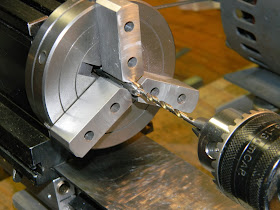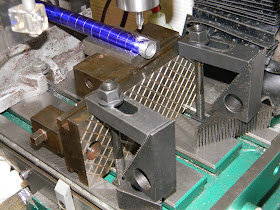I was looking for a project that didn't entail going out into the 15 degree F garage yesterday, so this rose to the top of the pile by default--or perhaps by aversion. This is the Crosman aluminum breech project from a few months ago. The shroud is a bit plain.

Removed the breech from the gun.
While the loading bolt is out of the gun, it needs a magnet to hold it open during loading. That's a tiny rare earth magnet in the jaws of the caliper.
Chucked the bolt in the Taig lathe and spotted the hole.
Followed with a #31 bit.
Epoxied the magnet into place.

A quick clean up pass on the lathe and it's done.
OK, on the the main feature. Removed the vanilla shroud off the barrel.
I got asked about holding round work pieces the other day, so I thought I'd take a moment to show the basic procedure. When you need to clamp a round item, a collet is the ticket. This is a 0.750" 5C collet. "5C" is a size. It refers to the dimensions of the collet body--the length, diameter, taper angle, body thread... There are dozens of collet size "standards" out there, but 5C is the most common for work holding. There are other collet types that are typically used to hold tooling--my milling machine, for instance, accepts R8 size collets. Apologies if this is too "step-by-step". Just skip ahead if you don't need the details.
The shroud (the work) goes into the collet then the collet is mounted in a special holder.
In this case, I'm going to use a six-sided (hex) block.
Collet is loaded into the block...
End of the collet is threaded for a lockring. Tightening the lockring pulls the collet into the angled front of the block causing the nose to slightly collapse inward tightly gripping the workpiece so it can't move.
Block then gets clamped in a vise. Mounted a stop on the vise, so each time I remove the block it can be reinstalled to the same location in the vise. A six-sided hex block allows for easy, 30 degree rotation of the workpiece while maintaining center. It probably sounds much more complicated than it really is.
Since I've gone this far, here's an easy way to drill the shroud. With some layout dye, I scratched lines every 0.500" down the length of the shroud.
Supported the muzzle end with a second vise holding a v-block.
A #4 (5/16") center drill was used to spot and drill each hole. Locked the y-axis and simply cranked the x-travel to every second line (1.000 inch intervals) and drilled.
Rotated the block 60 degrees (2 turns of the block in the vise) and drilled on the same series of lines as the first row. Repeat a third time.
Next, rotated the block 30 degrees in the vise and drilled the mid lines.
These holes are also 1.000" apart, but offset by 0.500" from the first series of holes. Rotate the block 60 degrees and drill, then repeat.
Removed the layout fluid and deburred.
Some polishing...
And reassembly.
Dressed up in fancier grips from an earlier 22XX project.
The gun has a bit more flavor now. The raw aluminum definitely gives it an unfinished tool-room feel. Well, like I said, it's a project gun.
Thanks for reading.



























I love the holes in the shroud, and the wood grips ties it all together.
ReplyDeleteHelios calipers are really nice, I have a 11 or 12 inch dial caliper by Helios, really nice to read and accurate.
Can't beat German tools....
I just recently found your blog and quickly becomming a fan, excellent work and very clearly explained. Many Thanks.
ReplyDeleteI hate to go off topic but I studied your work on the Daisy 717, and have a question. As the brass is softer than the aluminum casting could the leak have been from stretching the compression tube and deforming the holes for the lugs?
I have the same problem and the holes in the tube look just as oval as the ones in the casting.
Any opinion?
Wayne
I just recently found your blog and quickly becomming a fan, excellent work and very clearly explained. Many Thanks.
ReplyDeleteI hate to go off topic but I studied your work on the Daisy 717, and have a question. As the brass is softer than the aluminum casting could the leak have been from stretching the compression tube and deforming the holes for the lugs?
I have the same problem and the holes in the tube look just as oval as the ones in the casting.
Any opinion?
Wayne
Check this Daisy 7XX post:
ReplyDeletehttp://anotherairgunblog.blogspot.com/2009/12/daisy-717-repair-part-3-final.html
Derrick
El trabajo es magnífico!!! no conocía este blog. Estoy en España y ,e interesaría conocer dónde puedo encontrar el adaptador de 12 gramos para Air Source, para sustituir la botella de CO2 de mi Walther CP3 por estos cartuchos más cómodos. Puedes darme alguna referencia en europa o EEUU? Gracias. mi email es: enaranjom@yahoo.es
ReplyDeleteEl artículo es magnífico y la transformación del arma. Podrías infprmarme de dónde puedo conseguir eladaptador de 12 gramos para Air Source, lo necesito para una W·alther CP3
ReplyDelete